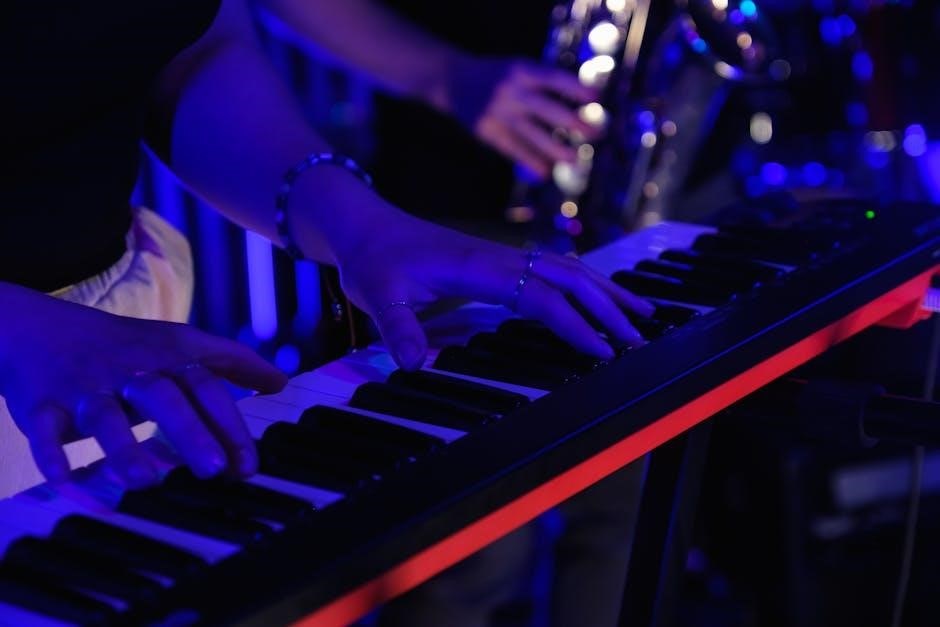
The Virtuoso Pianist by Charles-Louis Hanon is a renowned piano exercise book first published in 1873. It contains 60 exercises designed to enhance finger dexterity, speed, and strength. Available as a free PDF download, it remains a cornerstone in piano education, offering techniques for scales, arpeggios, and advanced playing.
1.1 Overview of the Book
The Virtuoso Pianist by Charles-Louis Hanon is a comprehensive collection of 60 exercises designed to improve piano technique. Divided into three parts, the book focuses on finger dexterity, scales, arpeggios, and advanced technical skills. The exercises are progressive, starting with foundational finger independence and gradually increasing in difficulty. The first part emphasizes five-finger exercises to build agility and strength, while the second and third parts introduce scales, arpeggios, and complex techniques like octaves and trills. Available as a free PDF download, the book is widely used by pianists of all levels to enhance their technical proficiency and musical expression. Its structured approach makes it a timeless resource in piano education.
1.2 Importance in Piano Education
The Virtuoso Pianist holds a central place in piano education due to its systematic approach to technical development. Its 60 exercises are designed to build finger independence, strength, and dexterity, making it a foundational resource for pianists. The book’s structured progression ensures that students gradually master complex techniques, from basic finger exercises to advanced virtuosic skills. Available as a free PDF download, it remains accessible to pianists worldwide. Many teachers and students rely on Hanon’s exercises to establish a strong technical foundation, which is essential for performing a wide range of repertoire. Its enduring popularity underscores its importance as a timeless tool in piano pedagogy.
1.3 Brief History of the Publication
The Virtuoso Pianist was first published in 1873 by Charles-Louis Hanon in Boulogne-sur-Mer, France. Originally released in three volumes, it quickly gained prominence as a definitive guide for technical piano training. Over time, the exercises were compiled into a single, comprehensive collection of 60 studies. The book’s popularity led to its widespread adoption, and it remains a cornerstone of piano education. Today, the exercises are freely available as a PDF download, making them accessible to pianists worldwide. Its enduring relevance has also inspired digital adaptations and apps, ensuring its continued influence in modern piano pedagogy. This historical significance underscores its role as a foundational resource for pianists across generations.

Biography of Charles-Louis Hanon
Charles-Louis Hanon (1819–1900) was a French piano pedagogue and composer. His The Virtuoso Pianist in 60 Exercises is a cornerstone of piano education, now available as a free PDF.
2.1 Early Life and Education
Charles-Louis Hanon was born on July 2, 1819, in Renescure, France. His early life was marked by a deep connection to music, beginning piano lessons at a young age. Hanon demonstrated exceptional talent, leading to formal training that would shape his future as a composer and pedagogue. His educational journey laid the foundation for his contributions to piano technique, culminating in The Virtuoso Pianist, now widely available as a free PDF. This work reflects the rigorous training and dedication he experienced in his formative years, emphasizing finger dexterity and musical precision. Hanon’s early education and upbringing in France influenced his methodical approach to piano pedagogy, which remains influential today.
2.2 Contributions to Piano Pedagogy
Charles-Louis Hanon’s most significant contribution to piano pedagogy is his iconic book, The Virtuoso Pianist. Comprising 60 exercises, it systematically targets finger independence, strength, and dexterity. These exercises, available as a free PDF, have become foundational in piano education worldwide. Hanon’s method emphasizes gradual progression, starting with basic finger exercises and advancing to complex techniques like scales and arpeggios. His approach ensures comprehensive technical mastery, making it indispensable for pianists of all levels. By structuring exercises to address specific technical challenges, Hanon revolutionized how pianists approach practice, ensuring efficiency and effectiveness. His work remains a cornerstone in modern piano instruction, widely regarded as essential for achieving virtuosic skill. Hanon’s legacy endures through the continued use of his exercises by teachers and students globally.
2.3 Legacy in the Music World
Charles-Louis Hanon’s enduring legacy is defined by the profound impact of The Virtuoso Pianist on piano education. His exercises have shaped generations of pianists, becoming a cornerstone of technical training. The book’s availability as a free PDF has ensured its accessibility to musicians worldwide. Hanon’s methodical approach to finger dexterity, strength, and precision has influenced countless pianists, contributing to their technical mastery. His work remains relevant in modern piano education, with its structured exercises continuing to be a vital resource for achieving virtuosic skill. Hanon’s legacy endures as a testament to his innovative pedagogical approach, ensuring his influence remains timeless in the music world. His contributions are celebrated by pianists and educators globally, solidifying his place in musical history.
Structure of The Virtuoso Pianist
The Virtuoso Pianist is structured into three parts: Preparatory Exercises, Scales and Arpeggios, and Advanced Techniques. Each section systematically builds technical proficiency, available as a free PDF.
3.1 Part I: Preparatory Exercises
Part I of The Virtuoso Pianist focuses on foundational finger exercises to develop agility, independence, and strength. The exercises are designed to improve finger dexterity and wrist flexibility, with a gradual increase in complexity. Available as a PDF download, these initial studies emphasize proper hand positioning and evenness in playing. They serve as a crucial starting point for pianists, ensuring a solid technical base before advancing to more complex techniques. The exercises are structured to be practiced systematically, with metronome guidance to achieve precise timing and control. This section is particularly beneficial for beginners, providing a clear pathway to mastering fundamental piano skills. The PDF format allows easy access and practice, making it a valuable resource for pianists worldwide.
3.2 Part II: Scales and Arpeggios
Part II of The Virtuoso Pianist focuses on scales and arpeggios, essential for building technical proficiency. It includes major and minor scales, as well as arpeggios, to improve finger stretch, dexterity, and control. These exercises are designed to enhance the pianist’s ability to play with precision and fluidity. The scales are presented in a systematic manner, covering all keys to ensure comprehensive mastery. Arpeggios further develop finger independence and strength. Available as a PDF download, this section provides a structured approach to mastering these fundamental techniques. By practicing these exercises, pianists can achieve a high level of technical skill, preparing them for more advanced repertoire. The PDF format makes it easy to access and practice these exercises regularly.
3.3 Part III: Advanced Techniques
Part III of The Virtuoso Pianist focuses on advanced techniques, including octaves, trills, and double thirds. These exercises are designed to refine finger precision and achieve brilliance in performance. The section emphasizes complex fingerings and intricate patterns, pushing pianists to master challenging passages with ease. Available as a PDF download, this part of the book is ideal for advanced students seeking to refine their skills. The exercises build upon the foundational techniques developed in earlier sections, culminating in a comprehensive mastery of piano virtuosity. By practicing these advanced techniques, pianists can achieve a high level of technical proficiency and expressive control, essential for performing demanding repertoire. The PDF format ensures easy access to these exercises for dedicated practice and refinement.
Benefits of Practicing Hanon Exercises
Practicing Hanon exercises improves finger dexterity, enhances speed and precision, strengthens hand muscles, and boosts endurance. These benefits lead to a refined technique and expressive musicality, essential for mastering the piano repertoire. Consistent practice also fosters discipline and confidence. The exercises are widely available in PDF format, making them accessible for pianists of all levels to refine their skills and achieve artistic excellence. Regular dedication to Hanon’s exercises is a proven path to pianistic mastery and musical success.
4.1 Improved Finger Dexterity
Hanon’s exercises are specifically designed to enhance finger dexterity, a foundational skill for pianists. By focusing on individual finger independence and strength, these exercises help pianists achieve greater control and precision. The intricate fingerings and patterns in the exercises target each finger, improving coordination and reducing the likelihood of errors. Regular practice strengthens the muscles in the hands, allowing for more nuanced and expressive performances. Additionally, the exercises promote evenness in tone and touch, ensuring that each finger contributes equally to the overall sound. This focus on dexterity is particularly beneficial for mastering complex repertoire, making Hanon’s exercises indispensable for pianists seeking technical mastery.
4.2 Enhanced Speed and Precision
Hanon’s exercises are renowned for their ability to improve speed and precision in piano playing. The structured progression of exercises, starting with slower tempos and gradually increasing, allows pianists to build velocity while maintaining accuracy. The use of metronomes, as suggested in the exercises, helps develop a strong sense of rhythm and timing. By practicing scales, arpeggios, and complex fingerings, pianists can achieve fluidity and clarity in their playing. The repetitive nature of the exercises reinforces muscle memory, enabling faster and more precise execution of difficult passages. Over time, this training enhances the pianist’s ability to perform intricate compositions with confidence and technical mastery.
4.3 Strength and Endurance
Hanon’s exercises are designed to build finger strength and endurance, essential for mastering complex piano repertoire. The repetitive nature of the exercises, particularly in scales and arpeggios, helps develop muscular stamina. By practicing octaves, chords, and other demanding passages, pianists can gradually increase their tolerance for prolonged performances. The exercises also focus on evenness and control, ensuring that strength is paired with precision. Over time, this training enables pianists to tackle technically challenging pieces without fatigue, enhancing their overall technical proficiency and performance endurance. Regular practice of these exercises fosters the physical and mental resilience needed for advanced piano playing.
Historical Context of The Virtuoso Pianist
The Virtuoso Pianist, first published in 1873, emerged during the Romantic era, a period of intense musical innovation. Its exercises reflect the era’s emphasis on technical virtuosity and expressiveness, providing a systematic approach to piano technique that remains foundational in modern education.
5.1 Development of Piano Technique
The development of piano technique in the 19th century was transformative, with composers and pedagogues seeking to push the boundaries of musical expression. Hanon’s The Virtuoso Pianist emerged as a groundbreaking resource, providing a systematic approach to building technical mastery. Its exercises were designed to address the growing demands of Romantic-era music, which required greater finger dexterity, strength, and precision. By focusing on scales, arpeggios, and intricate finger independence, Hanon’s work laid the foundation for modern piano technique. The book’s structured progression from basic exercises to advanced challenges offered pianists a clear path to virtuosity, making it an indispensable tool for musicians of all levels. Its influence endures, shaping the technical proficiency of pianists worldwide.
5.2 Influence of Romantic-Era Music
The Romantic era’s emphasis on emotional depth and technical complexity heavily influenced the creation of Hanon’s The Virtuoso Pianist. Composers like Chopin and Liszt demanded greater expressiveness and dexterity, prompting the need for structured exercises to meet these challenges. Hanon’s work responded by providing a systematic approach to building the technical proficiency required for Romantic repertoire. The exercises focus on finger independence, strength, and precision, aligning with the era’s musical demands. By addressing these needs, Hanon’s book became a foundational tool for pianists aiming to master the intricate works of Romantic composers. Its enduring relevance underscores the lasting impact of Romantic-era music on piano pedagogy and technique.
5.3 Evolution of Piano Exercise Literature
The publication of Hanon’s The Virtuoso Pianist marked a significant milestone in the evolution of piano exercise literature. Prior to its release, technical exercises were often fragmented and lacked a comprehensive structure. Hanon’s systematic approach, organizing exercises to target specific technical challenges, set a new standard. The book’s popularity led to its widespread adoption, influencing subsequent exercise literature to follow a similar structured format. Over time, adaptations and modern interpretations have emerged, yet the core principles remain unchanged. This evolution reflects the ongoing need for effective technical training, solidifying Hanon’s exercises as a cornerstone in piano pedagogy.

How to Practice Hanon Effectively
To master Hanon’s exercises, start with slower tempos and gradually increase speed. Use a metronome to ensure accuracy and maintain consistent practice sessions. Prioritize proper hand positioning and posture to prevent fatigue and injury, ensuring long-term progress.
6.1 Setting Goals and Schedules
Setting clear goals and schedules is essential for effective practice of Hanon’s exercises. Start by defining specific, measurable objectives, such as mastering a certain number of exercises within a set timeframe. Create a daily practice routine, allocating time for warm-ups, technique work, and repertoire. Prioritize consistency, even if it means shorter practice sessions. Break down complex exercises into smaller sections and gradually combine them. Use a planner or app to track progress and stay motivated. Regularly review and adjust your goals to ensure steady improvement. A structured approach helps build discipline and maximizes the benefits of Hanon’s method.
6.2 Using Metronomes for Accuracy
A metronome is a vital tool for practicing Hanon’s exercises accurately. It helps develop a strong sense of rhythm and timing, which are crucial for technical proficiency. Start by setting the metronome at a slower tempo and gradually increase the speed as you gain confidence. For example, begin with the first exercise at 60 BPM and aim to reach 108 BPM. This method ensures precise execution and prevents the formation of bad habits. Regular use of a metronome also enhances your ability to play evenly and maintain a steady pulse. Many digital tools and apps now offer metronome features, making it easier than ever to integrate this practice into your daily routine and achieve the desired level of accuracy in Hanon’s exercises;
6.3 Maintaining Proper Hand Position
Maintaining proper hand position is essential when practicing Hanon’s exercises to ensure technical accuracy and prevent injury. Keep your fingers curved gently over the keys, with wrists relaxed and slightly raised. This allows for optimal finger independence and strength. Avoid flattening your fingers, as it can lead to fatigue and poor technique. Pay attention to hand alignment, ensuring your arms are at a comfortable height relative to the keyboard. Proper hand position promotes evenness in playing and helps develop the precise control needed for advanced techniques. Regular practice with mindful attention to posture and hand placement will reinforce these habits, making Hanon’s exercises more effective and enjoyable.

Common Criticisms and Controversies
Hanon’s exercises are criticized for their repetitive nature, potentially causing strain injuries. Some argue they lack musicality, focusing solely on technique rather than artistic expression. Alternatives are often sought.
7.1 Repetitive Strain Concerns
Hanon’s exercises have faced criticism due to their repetitive nature, which can lead to physical strain and injuries if not practiced carefully. The continuous finger movements and emphasis on speed may cause issues like carpal tunnel syndrome or tendonitis. Pianists often experience discomfort in the wrists and hands, particularly when exercises are performed without proper technique or warm-ups. Critics argue that the focus on repetition can overburden the muscles, leading to long-term damage if precautions are not taken. Many piano educators now recommend balancing Hanon exercises with stretching routines and ergonomic practices to mitigate these risks. Moderation and awareness are key to avoiding repetitive strain injuries while benefiting from Hanon’s technical training;
7.2 Lack of Musicality in Exercises
While Hanon’s exercises are highly regarded for their technical benefits, critics argue that they lack musicality. The repetitive and mechanical nature of the exercises can make them feel divorced from expressive music-making. Unlike pieces by composers like Chopin or Debussy, which emphasize emotion and interpretation, Hanon’s exercises focus solely on technical proficiency. This has led some educators to suggest that relying too heavily on Hanon can result in performances that lack nuance and feeling. To address this, many pianists and teachers recommend supplementing Hanon exercises with repertoire that fosters musical expression and interpretation. Balancing technical skill with artistic expression ensures a well-rounded musical education.
7.3 Alternatives to Hanon
While Hanon’s exercises remain popular, many pianists and educators explore alternatives to diversify their technical training. Works by Carl Czerny, such as The Art of Finger Dexterity, offer similar benefits with a more musical approach. Études by Dohnányi and Moszkowski provide advanced technical challenges. Additionally, contemporary methods like the Taubman Approach focus on ergonomics and injury prevention. Some teachers advocate for using repertoire pieces, like Bach’s Well-Tempered Clavier, to build technique through musical context. These alternatives aim to address concerns about repetitive strain and lack of musicality, offering a more holistic approach to piano study while still developing the technical mastery Hanon’s exercises are known for.

The Role of Hanon in Modern Piano Teaching
The Virtuoso Pianist remains a cornerstone in modern piano education, with its exercises integrated into lesson plans and adapted for various skill levels. Digital resources and apps now make Hanon’s techniques more accessible, ensuring its relevance in contemporary teaching.
8.1 Integration into Lesson Plans
Hanon’s exercises are widely incorporated into piano curricula, offering a structured approach to technical development. Teachers often begin with Part I, focusing on foundational finger dexterity, before progressing to scales and arpeggios in Part II. Advanced techniques in Part III are introduced as students gain proficiency. Many educators emphasize balancing Hanon exercises with repertoire pieces to maintain musicality; Digital versions of The Virtuoso Pianist in PDF and app formats enhance accessibility, allowing teachers to assign specific exercises and track progress. This integration ensures that Hanon’s method remains relevant, providing a comprehensive toolkit for pianists at all levels, from beginners to advanced players, while adapting to modern teaching strategies and technological advancements.
8.2 Adaptations for Different Skill Levels
Hanon’s exercises are adaptable to pianists of all skill levels, from beginners to advanced players. Teachers often modify the exercises by adjusting tempo, focusing on specific techniques, or breaking them into smaller sections. For instance, beginners might start with slower tempos and basic finger exercises, while advanced students can tackle complex pieces at higher speeds. The structured progression of Hanon’s method ensures that each skill level is appropriately challenged. Additionally, the availability of PDF versions allows for easy customization, enabling teachers to tailor exercises to individual needs. This flexibility makes Hanon’s The Virtuoso Pianist a versatile tool for pianists at every stage of their development.
8.3 Digital Resources and Apps
The digital age has revolutionized access to Hanon’s exercises through various resources and apps. Websites like Musopen.org offer free PDF downloads of The Virtuoso Pianist, enabling easy access for pianists worldwide. Additionally, apps such as Smart Pianist provide interactive tools to enhance practice, including metronomes and performance tracking. These digital platforms often include audio recordings and practice guides, making Hanon’s method more engaging and accessible. Furthermore, apps allow for customizable practice sessions, enabling pianists to focus on specific exercises or techniques. These resources have made Hanon’s timeless exercises more convenient and adaptable for contemporary learners, ensuring their relevance in modern piano education;

The Virtuoso Pianist in Popular Culture
Hanon’s exercises have inspired numerous references in media and film, often symbolizing rigorous piano training. The availability of PDF downloads has further popularized its cultural impact, making it a recognizable symbol of pianistic dedication in modern society.
9.1 References in Media and Film
Hanon’s The Virtuoso Pianist has been frequently referenced in media and film, often symbolizing rigorous piano training and dedication. Its iconic exercises are sometimes portrayed as a hallmark of pianistic discipline. Movies like The Pianist and Whiplash subtly nod to the influence of such technical studies. The availability of PDF downloads has further popularized its presence in cultural narratives, making it a recognizable symbol of artistic rigor. These references highlight the enduring legacy of Hanon’s work in both musical education and broader popular culture, showcasing its impact beyond the practice room.
9.2 Performances by Renowned Pianists
While Hanon’s The Virtuoso Pianist is primarily known for its exercises, its influence can be heard in performances by renowned pianists. Many virtuosos, such as Lang Lang and Yuja Wang, have likely trained with these exercises, demonstrating their technical mastery. The PDF availability of Hanon’s work has made it accessible for pianists worldwide, contributing to its enduring presence in classical music. Though specific performances solely dedicated to Hanon are rare, his exercises underpin the technical brilliance seen in many recitals. The widespread use of Hanon’s PDF ensures his methods continue to shape pianistic excellence across generations, making his legacy integral to the art of piano performance.
9.3 Cultural Impact
Hanon’s The Virtuoso Pianist has left an indelible mark on piano culture, shaping the technical foundation of countless pianists worldwide. Its widespread availability as a free PDF has democratized access to advanced training, making it a cornerstone of piano education globally. The exercises have influenced not only classical music but also other genres, as their technical rigor prepares pianists for diverse repertoire. Its enduring relevance has solidified its place in the cultural landscape of music education, ensuring its methods continue to inspire and train future generations of musicians. The PDF version has further amplified its reach, making it a timeless resource in the evolution of piano technique and musical culture.
The Virtuoso Pianist remains a timeless resource for pianists, offering a comprehensive foundation for technical mastery. Its availability as a free PDF ensures universal access, fostering musical excellence.
10.1 Summary of Key Points
The Virtuoso Pianist by Charles-Louis Hanon is a seminal work in piano education, comprising 60 exercises designed to cultivate speed, precision, and finger independence. First published in 1873, it remains a cornerstone for pianists of all levels, offering a structured approach to technical mastery; The exercises are divided into three parts: preparatory exercises, scales, and advanced techniques. Its availability as a free PDF download has made it accessible to a global audience, ensuring its enduring popularity. The book’s focus on building strength, dexterity, and musicality has solidified its place in the repertoire of pianists worldwide, making it an indispensable resource for both students and educators.
10.2 Encouragement for Aspiring Pianists
Embarking on the journey with Hanon’s The Virtuoso Pianist is a commendable step toward mastering piano technique. Aspiring pianists will find the exercises invaluable for building finger dexterity, strength, and precision. The availability of the PDF download ensures accessibility, allowing anyone to benefit from Hanon’s timeless methods. Embrace the exercises with consistency and patience, as progress may seem gradual but is assured. Begin with the preparatory exercises and gradually advance to more complex techniques. Remember, the goal is not just technical mastery but also musical expression. Stay committed, and you will witness remarkable improvement over time. The legacy of Hanon’s work continues to inspire pianists worldwide, proving that dedication and practice lead to excellence.
10.3 The Enduring Legacy of Hanon
Charles-Louis Hanon’s The Virtuoso Pianist has left an indelible mark on piano education since its publication in 1873. Its 60 exercises remain a cornerstone for pianists seeking technical mastery. The PDF download availability ensures its accessibility to modern learners. Hanon’s work bridges generations, offering foundational techniques that adapt to evolving musical demands. His exercises, focusing on finger independence and strength, are integral to training programs worldwide. The legacy endures as pianists and educators continue to rely on Hanon’s methods, solidifying his impact on piano pedagogy. As a testament to his contributions, The Virtuoso Pianist remains a vital resource, inspiring future musicians and preserving its place in the history of piano technique.